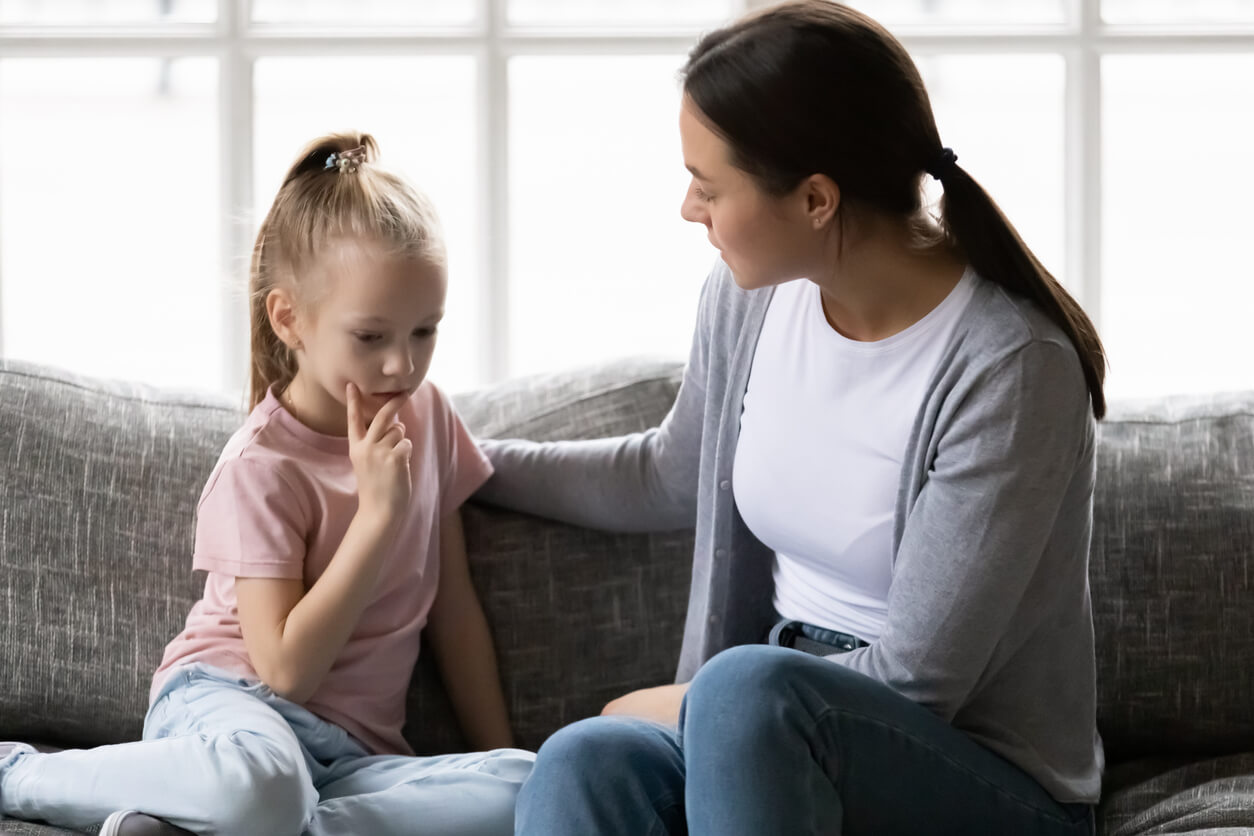Helping Children Adjust to School


Written and verified by the psychologist Maria Fátima Seppi Vinuales
School is an environment where children develop cognitive, emotional, and social skills. There, they get to know more about the world and themselves. They also make friends and learn how to behave in an environment that’s different from their home of origin. This institution is a place of learning that contributes to the development of children. However, in the beginning, adapting to school can present some challenges and difficulties. In the following article, we’ll tell you how you can help children adjust to school.
How to help children adjust to school
If you think about it, adjustment is a part of every new situation. Some people become comfortable more quickly than others. Also, there are those who are confident and those who take longer to feel comfortable until they get to know their teachers and classmates. That’s why children aren’t the only ones who need to adjust to school; it’s something that everyone needs when faced with a situation of change.
It’s important that we accompany children in this transition so that the school environment is pleasant and conducive to learning. Some recommendations to help children adjust to school are the following:
- Tell them about your own experience at school: This is a way to open the dialogue and facilitate the connection with the children. It also provides an opportunity for them to get their doubts out, express their fears, and find an adult as an interlocutor and supporter.
- Talk to them about the benefits of going to school: Teach them about the positive aspects of sharing a classroom with classmates, learning about new subjects, and playing together with others at recess.
- Pay attention to your child’s emotional states: Especially in the first few days, ask them how school went, what their favorite class is, what they do at recess, and how they manage their day.
- Observe if there are changes in their behavior in general: For example, you should be attentive if you notice any changes in regard to appetite, sleep, or their desire to play. This way, you’ll be able to monitor and watch for any signs that are out of the ordinary.
- Provide a transitional object or experience: Winnicott, a renowned psychoanalyst, refers to the objects that children use to feel secure in the absence of their parents. This transitional object, which can be, for example, a toy or a blanket, acts as a representative of their parents and symbolizes attachment.
- Share information about what will happen: Explain the day, the rules, and the activities they’ll have to face. This way, the scenario will be less unfamiliar to the child. According to their age, you can use different didactic resources. For example, through a story, a game about going to school, or a movie that deals with this situation.
You may be interested in: 8 Mistakes Parents Make On the First Days of School

Flexibility and respect are keys in the process of helping your child adjust to school
All of the above measures are recommendations that can make it easier for children to feel at ease at school. However, there are two essential values in this process: Flexibility and respect. Both imply active listening and a close and attentive receptivity to what’s happening to them in this process.
It’s a matter of adjusting our expectations, of going beyond what the experts and the books indicate to allow the children’s own voice to guide us in the experience. In this way, we also open a two-way communication channel, which makes it easier for them to feel confident to share any problems they may have.
Finally, we must also accept our own emotions and fears about the children’s first time at school. Being honest about our concerns, discussing them with the teaching staff, or asking other families for suggestions can help us to help our child. If we feel confident, we can also convey that calmness.
You may be interested in: What Should the 21st Century Schools Century Look Like?

“Being part” of the adaptation
When we think about how to favor the processes of adapting to school, we design an experience that transcends the specific school space. It’s about being the support and accompanying the emotional needs of children. This way, we contribute to their security, self-esteem, school cohesion, and strategies that will allow them to face difficulties and solve challenges in the best possible way.
That’s why this time of the year shouldn’t be taken lightly. Adaptation to school shakes the terrain of what our children are familiar with. It’s not just a matter of depositing them at the school door, but of being part of this time in their life. When we take this time as a mere formality and are guided by certain rigid positions, we run the risk of school becoming a feared place. In this regard, during the first days, we should try to organize our agenda and be available to share the first school activities and the unforeseen events that may arise.
School is an environment where children develop cognitive, emotional, and social skills. There, they get to know more about the world and themselves. They also make friends and learn how to behave in an environment that’s different from their home of origin. This institution is a place of learning that contributes to the development of children. However, in the beginning, adapting to school can present some challenges and difficulties. In the following article, we’ll tell you how you can help children adjust to school.
How to help children adjust to school
If you think about it, adjustment is a part of every new situation. Some people become comfortable more quickly than others. Also, there are those who are confident and those who take longer to feel comfortable until they get to know their teachers and classmates. That’s why children aren’t the only ones who need to adjust to school; it’s something that everyone needs when faced with a situation of change.
It’s important that we accompany children in this transition so that the school environment is pleasant and conducive to learning. Some recommendations to help children adjust to school are the following:
- Tell them about your own experience at school: This is a way to open the dialogue and facilitate the connection with the children. It also provides an opportunity for them to get their doubts out, express their fears, and find an adult as an interlocutor and supporter.
- Talk to them about the benefits of going to school: Teach them about the positive aspects of sharing a classroom with classmates, learning about new subjects, and playing together with others at recess.
- Pay attention to your child’s emotional states: Especially in the first few days, ask them how school went, what their favorite class is, what they do at recess, and how they manage their day.
- Observe if there are changes in their behavior in general: For example, you should be attentive if you notice any changes in regard to appetite, sleep, or their desire to play. This way, you’ll be able to monitor and watch for any signs that are out of the ordinary.
- Provide a transitional object or experience: Winnicott, a renowned psychoanalyst, refers to the objects that children use to feel secure in the absence of their parents. This transitional object, which can be, for example, a toy or a blanket, acts as a representative of their parents and symbolizes attachment.
- Share information about what will happen: Explain the day, the rules, and the activities they’ll have to face. This way, the scenario will be less unfamiliar to the child. According to their age, you can use different didactic resources. For example, through a story, a game about going to school, or a movie that deals with this situation.
You may be interested in: 8 Mistakes Parents Make On the First Days of School

Flexibility and respect are keys in the process of helping your child adjust to school
All of the above measures are recommendations that can make it easier for children to feel at ease at school. However, there are two essential values in this process: Flexibility and respect. Both imply active listening and a close and attentive receptivity to what’s happening to them in this process.
It’s a matter of adjusting our expectations, of going beyond what the experts and the books indicate to allow the children’s own voice to guide us in the experience. In this way, we also open a two-way communication channel, which makes it easier for them to feel confident to share any problems they may have.
Finally, we must also accept our own emotions and fears about the children’s first time at school. Being honest about our concerns, discussing them with the teaching staff, or asking other families for suggestions can help us to help our child. If we feel confident, we can also convey that calmness.
You may be interested in: What Should the 21st Century Schools Century Look Like?

“Being part” of the adaptation
When we think about how to favor the processes of adapting to school, we design an experience that transcends the specific school space. It’s about being the support and accompanying the emotional needs of children. This way, we contribute to their security, self-esteem, school cohesion, and strategies that will allow them to face difficulties and solve challenges in the best possible way.
That’s why this time of the year shouldn’t be taken lightly. Adaptation to school shakes the terrain of what our children are familiar with. It’s not just a matter of depositing them at the school door, but of being part of this time in their life. When we take this time as a mere formality and are guided by certain rigid positions, we run the risk of school becoming a feared place. In this regard, during the first days, we should try to organize our agenda and be available to share the first school activities and the unforeseen events that may arise.
All cited sources were thoroughly reviewed by our team to ensure their quality, reliability, currency, and validity. The bibliography of this article was considered reliable and of academic or scientific accuracy.
- Pacheco Sanz, Deilis-Ivonne; Díez González, Mº del Carmen; García Sánchez, Jesús- Nicasio
¿CÓMO INFLUYE LA ADAPTACIÓN ESCOLAR Y LAS HABILIDADES SOCIALES EN LOS ALUMNOS?
International Journal of Developmental and Educational Psychology, vol. 3, núm. 1, 2010, pp. 871-878
Asociación Nacional de Psicología Evolutiva y Educativa de la Infancia, Adolescencia y Mayores
Badajoz, España. - Albornoz Zamora, Elsa Josefina. (2017). LA ADAPTACIÓN ESCOLAR EN LOS NIÑOS Y NIÑAS CON PROBLEMAS DE SOBREPROTECCIÓN. Revista Universidad y Sociedad, 9(4), 177-180. Recuperado en 18 de septiembre de 2022, de http://scielo.sld.cu/scielo.php?script=sci_arttext&pid=S2218-36202017000400024&lng=es&tlng=es.
This text is provided for informational purposes only and does not replace consultation with a professional. If in doubt, consult your specialist.








